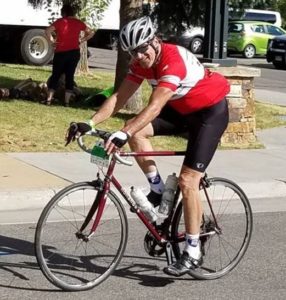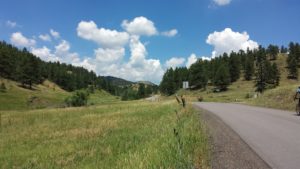I had never before felt so ready for a big bike ride. I had trained hard and even set a few personal records on some climbs around my home away from home here in Evergreen, Colorado. And at 70 years old, personal bests on the bike are generally behind me, unless I’m sucking the wheel of a sprite 50-year old.
But the Triple Bypass presents some monumental challenges for me. Just the sheer scope of it, 117 miles with more than 10,000 feet of climbing, is daunting for a guy who usually doesn’t like really long rides and lives at sea level with only bridges that exceed 1%. And at 187 lbs., I’m not built for climbing. But I felt ready.
Not ready enough. The first climb, through Juniper Pass, is the toughest. I had set a goal of one hour and 50 minutes for this nearly 15-mile, 3,300 ft. climb. Power meters on bikes allow you to measure watts, which is the power you are expending. It’s probably the best way to measure your effort. I wanted to average 150 watts of power. I missed my time goal by six minutes, but my wattage was on target. Problem was my target was too ambitious. By mile 50 I was beginning to flag. My wattage was dropping precipitously. People were passing me like I was standing still—young guys, old guys, skinny guys, fat guys, big gals, little gals. It was humbling. One guy, obviously very fit, was wearing a body suit with padding that made him look fat. Rub it in, pal!
From Georgetown to the top of Loveland Pass, the continental divide at nearly 12,000 feet, is relentless. While the average grade over that 16-mile stretch is 4%, there are many sections in double digits and few flat or downhill spots to recover. After that, Vail Pass, at 10,500 feet, seemed easy—if it didn’t come after the 87 miles before it.
At times I wondered why I was doing this. Yes, we bike riders love to challenge ourselves, compare ourselves and, for reasons psychiatrists could have a field day, “suffer.” I was questioning my own sanity.
I estimate I came in somewhere down in the top 60-70 percentile of the 3,500 riders. It looks like about a third of the cyclists posted their rides on Strava, a cycling app that allows you to record your ride and compare your efforts to others’. About 15 who completed the Triple Bypass and posted on Strava were over 70.
After I finished I had a chance to watch others come in. Virtually all of them had smiles on their faces (like me in the attached photo at the finish). Many whooped it up and raised their arms as if they’d just won a Tour de France stage. As I walked through the crowd, riders were exchanging stories about something funny that happened along the way or where they were really “suffering.” Sometimes I think we ride just so we can talk about it afterwards. After all, that’s the usual topic of conversation at my St. Pete coffee shop every morning after our group rides. At Nottingham Park in Avon, if you caught a stranger’s eye for a second, he or she would invariably ask, “How was your ride?” Even if they didn’t know you, they seemed to want to know that you were OK.
My overall time was 28 minutes faster than when I did this ride four years ago, but that was because I didn’t dawdle at the rest stops. My moving time, according to Strava was, coincidentally, 28 minutes slower. But then, as we get older, we tend to move slower.
I got some chicken and rice at the food tent, took a shower at the nearby rec center, and then my wife, brother and I headed back to Evergreen. Part of the Triple Bypass route runs along I-70. We could see quite a few riders still on the course. I hope they didn’t get swept up by the SAG cars. I hope they got to raise their arms at the finish and let out a primal scream.



